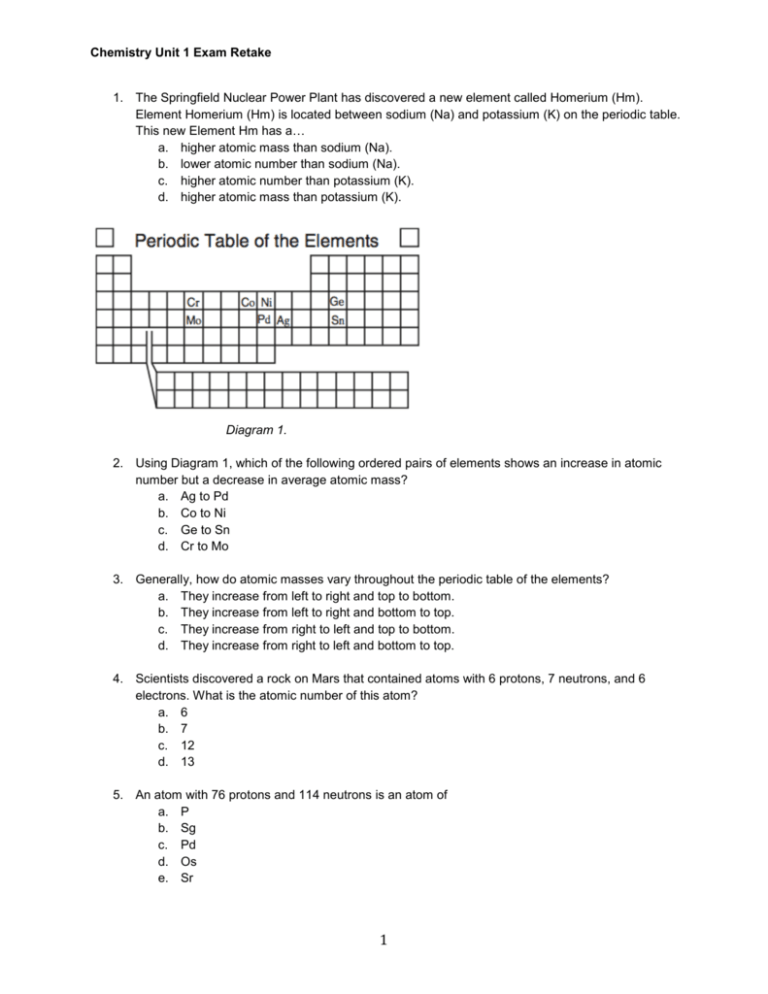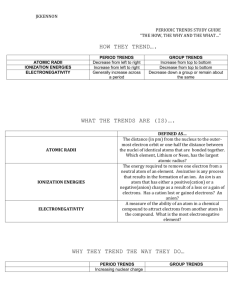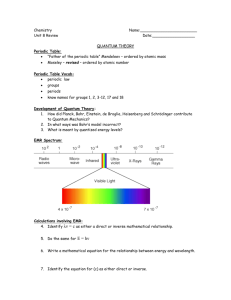Chemistry Benchmark 1
advertisement

Chemistry Unit 1 Exam Retake 1. The Springfield Nuclear Power Plant has discovered a new element called Homerium (Hm). Element Homerium (Hm) is located between sodium (Na) and potassium (K) on the periodic table. This new Element Hm has a… a. higher atomic mass than sodium (Na). b. lower atomic number than sodium (Na). c. higher atomic number than potassium (K). d. higher atomic mass than potassium (K). Diagram 1. 2. Using Diagram 1, which of the following ordered pairs of elements shows an increase in atomic number but a decrease in average atomic mass? a. Ag to Pd b. Co to Ni c. Ge to Sn d. Cr to Mo 3. Generally, how do atomic masses vary throughout the periodic table of the elements? a. They increase from left to right and top to bottom. b. They increase from left to right and bottom to top. c. They increase from right to left and top to bottom. d. They increase from right to left and bottom to top. 4. Scientists discovered a rock on Mars that contained atoms with 6 protons, 7 neutrons, and 6 electrons. What is the atomic number of this atom? a. 6 b. 7 c. 12 d. 13 5. An atom with 76 protons and 114 neutrons is an atom of a. P b. Sg c. Pd d. Os e. Sr 1 Chemistry Unit 1 Exam Retake 6. An element found at the right end of period 4 of the periodic table will have a lower atomic number than ANY element found a. in period 3. b. in period 5. c. in group 2. d. in group 14. Diagram 1. 7. Most of the elements specifically named in Diagram 1 (Cr, Co, Ni, Ge, Mo, Pd, Ag, Sn) are part of the _____________ family. a. alkaline earth metal b. transition metal c. alkali metal d. halogen 8. A scientist forgot to label the chemicals in the lab. She looks at a mystery substance and observes that the substance is shiny, solid, and magnetic. This substance is most likely a __________, which is located near the ______________________ of the periodic table. a. metal; right side b. non-metal; right side c. metal; left side or middle d. non-metal; left side or middle 9. Only one of the elements in this family is a semimetal (metalloid). a. alkaline earth metal b. halogen c. transition metal d. noble gas 10. Which of the following is a nonmetal? a. copper (Cu) b. aluminum (Al) c. rubidium (Rb) d. sulfur (S) 11. The periodic table consists mainly of a. metals 2 Chemistry Unit 1 Exam Retake b. nonmetals c. semimetals (metalloids) d. gases 12. Group 2 of the periodic table can also be called a. halogens b. alkaline earth metals c. alkali metals d. transition metals 13. Which of the following elements is NOT a solid at room temperature? a. Au b. Fe c. Ne d. Al 14. Which atom will have the lowest electronegativity: oxygen, barium, or iron? a. Oxygen b. Barium c. Iron d. All have the same electronegativity. 15. Atom X has a high ionization energy. Which of the following statements are true about Atom X? a. Not that much energy is needed to remove an electron from Atom X. b. Not that much energy is needed to add an electron from Atom X. c. A lot of energy is needed to remove a proton from Atom X. d. A lot of energy is needed to remove an electron from Atom X. 16. Arrange the following atoms in order from largest to smallest atomic radius: K, Cl, Br, Ca a. K > Ca > Br > Cl b. Ca > Br > K > Cl c. Cl > K > Br > Ca d. K > Ca > Br > Cl 17. Walter is conducting an experiment by reacting alkali metals with water. He observes that potassium reacts much more violently than sodium. What is one explanation for this observation? a. Sodium has a higher electronegativity than potassium b. Sodium has a lower electronegativity than potassium c. Sodium has a higher ionization energy than potassium d. Sodium has a lower ionization energy than potassium 18. Which of the following has the largest atomic radius? a. Sr b. I c. Ca d. Cl 3 Chemistry Unit 1 Exam Retake 19. Which of the following has the largest electronegativity? a. K b. C c. N d. O 20. How many electrons does boron (B) need to fill its outer energy level? a. 1 b. 3 c. 5 d. 7 21. The halogens contain how many valence electrons? a. 0 b. 1 c. 7 d. 8 22. Lithium (Li) will likely form an ionic bond with an atom from the _________ family. a. noble gas b. transition metal c. alkali metal d. halogen 23. Atoms from the noble gas family are not usually reactive because… a. noble gas atoms have a full valence shell. b. noble gas atoms do not have any valence electrons. c. all gases are negatively charged because they are non-metals. d. only metals react with other molecules. 24. Which of the following elements would have chemical properties most similar to calcium? a. Br b. Na c. Fe d. Sr 25. Which combination of elements would most likely form a covalent bond? a. sodium (Na) and iodine (I) b. magnesium (Mg) and oxygen (O) c. nitrogen (N) and oxygen (O) d. tin (Sn) and oxygen (O) 26. Covalent bonding involves the _____________ of electrons, and ionic bonding involves the __________ of electrons. a. transfer; sharing b. sharing; transfer c. sharing; reaction d. transfer; reaction 4 Chemistry Unit 1 Exam Retake 27. Ionic bonds form when two atoms a. transfer outer shell electrons. b. transfer inner shell electrons. c. share inner shell electrons. d. share outer shell electrons. 28. Which of these does NOT contain a covalent bond? a. CH4 b. NH3 c. Na2O d. CO2 29. A compound containing carbon (C), oxygen (O), hydrogen (H), and nitrogen (N) would be bonded together by ____ electrons in order to ____ their outer energy levels. a. gaining; fill b. losing; empty c. sharing; fill d. sharing; empty 30. To obtain noble gas configuration an atom of calcium must a. gain two electrons b. lose two electrons c. gain one electron d. lose six electrons 5






